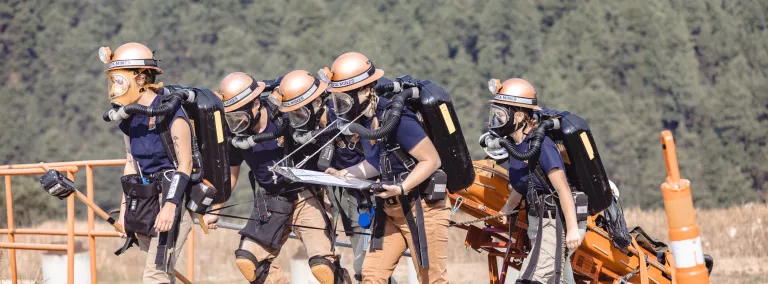This is a drill: students participate in simulated mine rescue
Students from South Dakota Mines, Colorado School of Mines gain valuable experience in simulated mine rescue
In the maze of tunnels beneath the Waste Water Treatment Plant at the Sanford Underground Research Facility (SURF), a handful of rescuers moved cautiously through a thick haze of smoke searching for a missing person. In their hands, they held a vague map of the area and gas testers with technical problems. All were “under air,” with each carrying a 50-pound self-contained breathing apparatus (SCBA) as they searched for clues.
“They couldn’t see their hands in front of their faces,” said Alec Weber, a senior at South Dakota Mines (Mines), “but they had to find the source of the smoke so they could rescue the person.”
The simulated experience was designed by Weber, who has been on the Mines rescue team since he was a freshman. Weber also invited students from Colorado School of Mines (CSM) to participate in the exercise.
“The goal was to help the teams better understand ventilation and their surroundings in a situation like this and to figure out what actually went wrong,” Weber said.
In the real world, emergency rescue teams often face the unknown. They need to know how to react under pressure and to be prepared for worst-case scenarios.
“Mining is inherently more dangerous than working on the surface,” Weber said. “As engineering students and science students who might work underground or become firefighters or EMTs, it’s a great opportunity to practice these hands-on-skills in an environment like SURF.”
Paul “Woody” Hover has been a member of mine rescue and emergency response teams for more years that he cares to count. As the ERT lead at SURF, Hover regularly develops drills that cover a wide array of scenarios. When Weber approached several months ago about doing a mock drill at SURF, Hover immediately said, “Yes.”
“This kind of training is critical, period,” Hover said. “It is especially critical for students who work in mining or related fields because they are better prepared, better equipped and better able to handle emergencies emotionally.
“You want these exercises to be as realistic as possible,” Hover continued. “This drill put a lot of stressors on the students and both groups did a good job.”
Camille Kaufman, a senior at CSM who is studying mechanical engineering and minoring in robotics and intelligent systems, loves being a part of the school’s mine rescue club and serves as her team’s “benchman,” the person who tests the BG4s, or breathing apparatus.
“Training at SURF was a valuable opportunity for our team to learn from industry professionals and other collegiate teams about responding to heavy smoke environments, underground exploration, medical scenarios and troubleshooting,” she said. “To be able to do that at a place with so much historical and scientific significance made the experience all the more interesting and meaningful.”
Weber has been creating scenarios for some time as the captain of the Mines rescue team—several of which took place at SURF. But his first experience at the research facility was as an intern in 2018.
“It was a really good opportunity to see things the way they actually are in the industry,” Weber said. “The people at SURF came from different places—Stillwater, Homestake, Wharf (mines)—and I could take all the best practices with me. And the emphasis on safety was really helpful.”
Weber will graduate from Mines in December of 2022. For the past year, he’s focused on training other students.
“I want to teach the team some of what I learned. That way, the knowledge is passed down when I inevitably graduate,” he said.
And the final drill at SURF is a good ending to his college career.
“It was really cool to see the level of interest the SURF team showed in helping us learn and their willingness to learn from us,” Weber said, then added, “They seem to like having us here and help the team quite a bit in terms of logistics and knowledge sharing. It’s a good relationship.”
